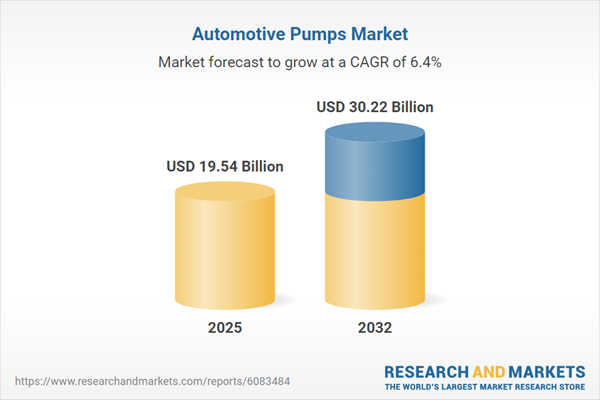Speak directly to the analyst to clarify any post sales queries you may have.
The global automotive pumps market is experiencing a fundamental shift as electrification, regulatory change, and advanced vehicle architectures reshape technology priorities and operational expectations for senior decision-makers.
Market Snapshot: Automotive Pumps Market Size, Growth, and Strategic Drivers
The automotive pumps market is growing steadily, rising from USD 18.41 billion in 2024 to USD 19.54 billion in 2025, with projections to reach USD 30.22 billion by 2032. This trajectory reflects a compound annual growth rate (CAGR) of 6.39%. Sustained expansion is influenced by the increasing need for both electric and mechanical pump solutions, addressing the demands of OEM and aftermarket channels. Several drivers are evident: the global focus on powertrain efficiency, stricter emission regulations, and the push for higher productivity and system reliability. With these factors in play, industry executives are recalibrating their approach to technology adoption, value chain dynamics, and sourcing decisions as the supply chain becomes more complex and strategic in shaping the future of automotive mobility.
Scope & Segmentation
- Pump Types: Includes cooling pumps (both electric and mechanical), fuel pumps (covering high-pressure and low-pressure configurations), oil pumps (gear, piston, and vane designs), vacuum pumps (roots and rotary vane), and water pumps (electric and mechanical formats). Each category serves critical roles in optimizing thermal management, emissions, and component durability for vehicle applications.
- Vehicle Types: Encompasses commercial vehicles—heavy-duty and light-duty—and passenger cars. Fluid handling requirements differ by duty cycle and operational environment, with commercial fleets prioritizing durability and passenger cars focusing on noise, efficiency, and minimal maintenance.
- Fuel Types: Addresses diesel, electric (including battery and fuel cell models), gasoline, and hybrid vehicles. Advanced pump technologies are tailored to support the variable architectures of hybrids (parallel, series, and series-parallel) and stringent operational demands of electrified platforms.
- Sales Channels: Covers OEMs and aftermarket suppliers. OEM routes enable integration of next-generation technologies into new vehicles, while the aftermarket segment brings upgrade and retrofitting potential, extending vehicle lifecycles and supporting sustainability initiatives.
- Regional Coverage: Global scope includes the Americas (North and Latin America), EMEA (Europe, Middle East, and Africa), and Asia-Pacific. Notable markets feature the United States, Canada, Mexico, Brazil, Germany, the United Kingdom, China, Japan, India, and South Korea, with regional factors such as regulatory trends, supply chain maturity, and local manufacturing capacity influencing adoption rates and technology preferences.
- Companies Covered: Key participants are Robert Bosch GmbH, Denso Corporation, Aisin Seiki Co., Ltd., Mahle GmbH, Continental AG, Hitachi Automotive Systems, Ltd., Valeo SA, BorgWarner Inc., Pierburg GmbH, and Tenneco Inc. These organizations drive innovation, execution, and reliability across the market segments and geographies outlined above.
Key Takeaways for Senior Decision-Makers
- Electrification and the integration of smart pump systems are redefining operational benchmarks, with intelligent fluid management and predictive maintenance capabilities now fundamental to maintaining competitiveness and compliance.
- Hybrid pump modules, combining electric and mechanical technologies, are integral to the evolving needs of next-generation powertrains, supporting balances of thermal control and system efficiency across diverse vehicle classes.
- Material innovation, particularly through lightweight composites and advanced design techniques, underpins reductions in pump mass and improvements in long-term durability, enhancing vehicles' capability under rigorous use conditions.
- Collaboration between OEMs, tier-one suppliers, and dedicated technology providers is advancing modular pump designs. This allows manufacturers to respond with precision to quickly shifting regulatory directives and the diverse technical requirements across vehicle types and global markets.
- The rise of digitalization—via sensors and advanced cloud analytics—enables real-time monitoring, reliability, and system optimization, directly supporting connected vehicle strategies and smarter supply chain management.
- The development of robust aftermarket solutions through advanced retrofitting extends vehicle lifespan, optimizing environmental and operational value for companies managing mixed or legacy fleets.
Tariff Impact on Supply Chain and Sourcing Strategies
Recent shifts in United States tariff policy have prompted automotive pump manufacturers to reassess supply chain architectures. This has triggered increased regional value-add and a trend toward nearshoring, notably in North America. While initial transitions caused some disruption, firms now employ scenario planning and data-driven decision-making to mitigate risk and build flexible, resilient sourcing models. Enhanced analytics, scenario-based planning, and robust procurement methods are supporting enterprises as they adapt to ongoing global trade fluctuations.
Methodology & Data Sources
This analysis builds on primary research with senior executives and is validated through secondary reviews of technical and regulatory material. Data is triangulated with insights from engineering and materials specialists to ensure the information remains timely, actionable, and decision-ready for today’s fast-changing landscape.
Why This Report Matters
- Guides senior leaders in aligning R&D investment and capital allocation with emerging powertrain and digitalization trends.
- Empowers procurement and operational teams to effectively respond to supply chain and tariff disruptions through robust sourcing and agile inventory practices.
- Delivers comprehensive, actionable intelligence needed for sustained competitiveness and regulatory compliance across diverse vehicle and technology segments.
Conclusion
The automotive pumps market is advancing through electrification, digital integration, and material innovation. Organizations prioritizing flexible strategies and strong partnerships will remain ahead as sector transformation accelerates.
Table of Contents
3. Executive Summary
4. Market Overview
7. Cumulative Impact of Artificial Intelligence 2025
Companies Mentioned
The companies profiled in this Automotive Pumps market report include:- Robert Bosch GmbH
- Denso Corporation
- Aisin Seiki Co., Ltd.
- Mahle GmbH
- Continental AG
- Hitachi Automotive Systems, Ltd.
- Valeo SA
- BorgWarner Inc.
- Pierburg GmbH
- Tenneco Inc.
Table Information
| Report Attribute | Details |
|---|---|
| No. of Pages | 192 |
| Published | October 2025 |
| Forecast Period | 2025 - 2032 |
| Estimated Market Value ( USD | $ 19.54 Billion |
| Forecasted Market Value ( USD | $ 30.22 Billion |
| Compound Annual Growth Rate | 6.3% |
| Regions Covered | Global |
| No. of Companies Mentioned | 11 |









